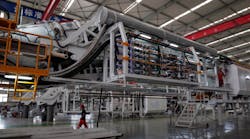BEIJING — Further signs of slowing in the world’s second-biggest economy sent shudders through global markets Tuesday, adding to the worldwide sense of crisis over China’s financial management.
European stock markets plunged at the opening, taking their lead from Asia, where bourses lost ground after the worst figures in three years from Chinese factory managers. Markets in Frankfurt and Paris dropped more than 3%, with London not much better off. That came after Tokyo shed nearly 4%, leading losses across most of the region.
The Chinese government’s Purchasing Managers’ Index (PMI), which measures activity in the country’s vast manufacturing sector, showed a slight contraction in August at 49.7. Analysts say official figures in China frequently underplay the severity of the situation.
The data, which come after global markets have been rocked by increasing fears over the health of the Chinese economy, highlight the task Beijing faces as it battles to keep a lid on a growing sense of crisis.
The PMI measurement was in line with the median estimate of economists by Bloomberg News, and was the lowest official measurement since August 2012, but was still better than an independent survey sponsored by Chinese media group Caixin: a 77-month low of 47.3, down from July’s 47.8. (The updated result, however, marked a slight improvement over the preliminary figure of 47.1 announced earlier.)
Analysts also cast further doubt on the ability of the communist leadership to manage China’s adjustment from the high-growth, investment-led model of the last three decades, toward a more sustainable approach.
China’s economy has been steadily slowing since the double-digit expansions of years past, the last of which came in 2010.
It grew 7.4% in 2014, its weakest since 1990, but has slowed further this year, to 7.0% for each of the first two quarters.
Blue skies, but gray outlook
The Chinese economy — which accounts for one dollar in every eight of global GDP — has been a lone bright spot since a global slowdown began in 2008. Its strength has largely been fueled by massive state spending and huge monetary stimulus, but analysts agree it needs to switch more toward consumer spending.
Investors worry that a failure to manage that re-tooling properly could provide a nasty bump for the Chinese economy — and much of the rest of the world. But recent months have offered little comfort.
China’s central bank last week cut its benchmark interest rates for the fifth time since November and also further reduced the amount of cash banks must keep on hand. Since peaking on June 12, Shanghai stocks have plunged nearly 40%, prompting broad government interventions to try to shore up domestic exchanges.
In the latest move, Beijing urged listed companies late Monday to merge and restructure, pay cash dividends and buy back their own shares — which should see prices rise — in an effort to encourage investors to hold stock for the long term. The central People’s Bank of China has pumped 290 billion yuan ($45.56 billion) into the money market over the past two days, according to a statement, to shore up confidence.
The statistics bureau said separately on Tuesday that efforts to control pollution in Beijing, Tianjin and neighboring Hebei province had weighed on factory activity. That has been particularly marked over recent weeks around Beijing, where authorities have ordered heavy-polluting plants to shutter in a bid to help clear the air in the Chinese capital ahead of a military parade on Thursday.
Julian Evans-Pritchard, China economist at Capital Economics, noted that similar dips were recorded ahead of other important events in the Chinese capital, such as the 2008 Olympics, when “efforts were made to ensure blue skies.”
But as disruption from the pollution measures fades and credit growth and fiscal spending pick up “a sustained rebound in economic activity over the coming quarters seems likely,” he wrote.
In one positive sign however, a private survey released Tuesday showed signs of life in China’s long-suffering property market, an important sector for the economy.
New house prices recorded their first year-on-year rise in 11 months in August, the China Index Academy said, as government monetary easing policies boosted demand.
However, ANZ economists Liu Li-Gang and Louis Lam said in a research note that despite the central bank’s monetary easing actions more stimulus measures were needed, calling for “proactive fiscal policy” and “more financial liberalization.”
By Kelly Olsen
Copyright Agence France-Presse, 2015



